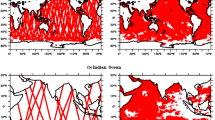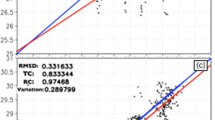Abstract
Hourly sea surface temperature (SST) observations from the geostationary satellite are increasingly used in studies of the diurnal warming of the surface oceans. The aim of this study is to derive the spatial and temporal distribution of diurnal warming in the China seas and northwestern Pacific Ocean from Multi-functional Transport Satellite (MTSAT) SST. The MTSAT SST is validated against drifting buoy measurements firstly. It shows mean biases is about–0.2°C and standard deviation is about 0.6°C comparable to other satellite SST accuracy. The results show that the tropics, mid-latitudes controlled by subtropical high and marginal seas are frequently affected by large diurnal warming. The Kuroshio and its extension regions are smaller compared with the surrounding regions. A clear seasonal signal, peaking at spring and summer can be seen from the long time series of diurnal warming in the domain in average. It may due to large insolation and low wind speed in spring and summer, while the winter being the opposite. Surface wind speed modulates the amplitude of the diurnal cycle by influencing the surface heat flux and by determining the momentum flux. For the shallow marginal seas, such as the East China Sea, turbidity would be another important factor promoting diurnal warming. It suggests the need for the diurnal variation to be considered in SST measurement, air-sea flux estimation and multiple sensors SST blending.
Similar content being viewed by others
References
Bellenger H, Duvel J P. 2009. An analysis of tropical ocean diurnal warm layers. Journal of Climate, 22(13): 3629–3646
Buongiorno Nardelli B, Marullo S, Santoleri R. 2005. Diurnal variations in AVHRR SST fields: A strategy for removing warm layer effects from daily images. Remote Sensing of Environment, 95(1): 47–56
Castro S L, Wick G A, Buck J J H. 2014. Comparison of diurnal warming estimates from unpumped Argo data and SEVIRI satellite observations. Remote Sensing of Environment, 140: 789–799
Clayson C A, Bogdanoff A S. 2013. The effect of diurnal sea surface temperature warming on climatological air-sea fluxes. Journal of Climate, 26(8): 2546–2556
Dash P, Ignatov A, Kihai Y, et al. 2010. The SST quality monitor (SQUAM). Journal of Atmospheric and Oceanic Technology, 27(11): 1899–1917
Donlon C J, Martin M, Stark J, et al. 2012. The operational sea surface temperature and sea ice analysis (OSTIA) system. Remote Sensing of Environment, 116: 140–158
Donlon C J, Minnett P J, Gentemann C, et al. 2002. Toward improved validation of satellite sea surface skin temperature measurements for climate research. Journal of Climate, 15(4): 353–369
Donlon C, Rayner N, Robinson I, et al. 2007. The global ocean data assimilation experiment high-resolution sea surface temperature pilot project. Bulletin of the American Meteorological Society, 88(8): 1197–1213
Eastwood S, Le Borgne P, Péré S, et al. 2011. Diurnal variability in sea surface temperature in the Arctic. Remote Sensing of Environment, 115(10): 2594–2602
Gentemann C L, Minnett P J, Le Borgne P, et al. 2008. Multi-satellite measurements of large diurnal warming events. Geophysical Research Letters, 35(22): L22602
Huang Weigen, Robinson I S, Wells N C. 1999. Diurnal SST warming in the bay of biscay: satellite measurements and model prediction. Acta Oceanologica Sinica, 18(2): 167–176
Karagali I, Høyer J L. 2014. Characterisation and quantification of regional diurnal SST cycles from SEVIRI. Ocean Science, 10(5): 745–758
Karagali I, Høyer J, Hasager C. 2012. SST diurnal variability in the North Sea and the Baltic Sea. Remote Sensing of Environment, 121: 159–170
Kawai Y, Kawamura H. 2005. Spatial and temporal variations of model-derived diurnal amplitude of sea surface temperature in the western Pacific Ocean. Journal of Geophysical Research, 110(C8): C08012
Kawai Y, Wada A. 2007. Diurnal sea surface temperature variation and its impact on the atmosphere and ocean: A review. Journal of Oceanography, 63(5): 721–744
Kim M J, Ou M L, Sohn E H, et al. 2011. Characteristics of sea surface temperature retrieved from MTSAT-1R and in-situ data. Asia-Pacific Journal of Atmospheric Sciences, 47(5): 421–427
Le Borgne P, Legendre G, Péré S. 2012. Comparison of MSG/SEVIRI and drifting buoy derived diurnal warming estimates. Remote Sensing of Environment, 124: 622–626
Li L. 1993. iSummer upwelling system over the northern continental shelf of the South China Sea: a physical description. In: Proceedings of the Symposium on the Physical and Chemical Oceanography of the China Seas. Beijing: China Ocean Press, 58–68
Lin Rui, Zhang Caiyun, Li Yan. 2014. Satellite observation of the temporal and spatial variation of sea surface diurnal warming in the South China Sea. Journal of Tropical Oceanography (in Chinese), 33(2): 17–27
Marullo S, Santoleri R, Banzon V, et al. 2010. A diurnal-cycle resolving sea surface temperature product for the tropical Atlantic. Journal of Geophysical Research-Oceans, 115: C05011
Maturi E, Harris A, Mittaz J, et al. 2008. NOAA’s sea surface temperature products from operational geostationary satellites. Bulletin of the American Meteorological Society, 89(12): 1877–1888
Merchant C J, Filipiak M J, Le Borgne P, et al. 2008. Diurnal warm-layer events in the western Mediterranean and European shelf seas. Geophysical Research Letters, 35(4): L04601
Nonaka M, Xie Shangping. 2003. Covariations of sea surface temperature and wind over the kuroshio and its extension: evidence for ocean-to-atmosphere feedback. Journal of Climate, 16(9): 1404–1413
O’Carroll A G, Eyre J R, Saunders R W. 2008. Three-way error analysis between AATSR, AMSR-E, and in situ sea surface temperature observations. Journal of Atmospheric and Oceanic Technology, 25(7): 1197–1207
Price J F, Weller R A, Pinkel R. 1986. Diurnal cycling: observations and models of the upper ocean response to diurnal heating, cooling, and wind mixing. Journal of Geophysical Research-Oceans, 91(C7): 8411–8427
Qiu B. 2002. The Kuroshio Extension system: Its large-scale variability and role in the midlatitude ocean-atmosphere interaction. Journal of Oceanography, 58(1): 57–75
Shenoi S S C, Nasnodkar N, Rajesh G, et al. 2009. On the diurnal ranges of Sea Surface Temperature (SST) in the north Indian Ocean. Journal of Earth System Science, 118(5): 483–496
Shi Wei, Wang Menghua. 2012. Satellite views of the Bohai Sea, Yellow Sea, and East China Sea. Progress in Oceanography, 104: 30–45
Stuart-Menteth A C, Robinson I S, Challenor P G. 2003. A global study of diurnal warming using satellite-derived sea surface temperature. Journal of Geophysical Research-Oceans, 108(C5): 3155
Su Jilan. 2004. Overview of the South China Sea circulation and its influence on the coastal physical oceanography outside the Pearl River Estuary. Continental Shelf Research, 24(16): 1745–1760
Sybrandy A L, Niiler P P, Martin C, et al. 2009. Global drifter programme drifter design reference. Technical report, Data Buoy Cooperation Panel Technical Document No. 4, revision 2.2: 1–47
Tanahashi S, Kawamura H, Takahashi T, et al. 2003. Diurnal variations of sea surface temperature over the wide-ranging ocean using VISSR on board GMS. Journal of Geophysical Research, 108(C7): 3216
Teng Weicheng, Guan Lei. 2012. Diurnal variation correction of AVHRR SST data for the Northwest Pacific region. Journal of Tropical Oceanography, 31(4): 1–7
Webster P J, Clayson C A, Curry J A. 1996. Clouds, radiation, and the diurnal cycle of sea surface temperature in the Tropical Western Pacific. Journal of Climate, 9(8): 1712–1730
Webster P J, Lukas R. 1992. TOGA COARE: the coupled ocean-atmosphere response experiment. Bulletin of the American Meteorological Society, 73(9): 1377–1416
Xu Feng, Ignatov A. 2014. In situ SST quality monitor (i Quam). Journal of Atmospheric and Oceanic Technology, 31(1): 164–180
Yan Yunwei, Chen Changlin, Ling Zheng. 2014. Warm water wake off northeast Vietnam in the South China Sea. Acta Oceanologica Sinica, 33(11): 55–63
Acknowledgements
MTSAT data were provided by JAMI and processed by Australian Bureau of Meteorology to retrieve the SST. The surface heat flux and wind speed data were obtained from NCEP/NCAR reanalysis dataset. The quality controlled drifting buoy SST was provided by iQuam/NOAA. The authors thank the anonymous reviewers for their constructive comments and suggestions on our manuscript.
Author information
Authors and Affiliations
Corresponding author
Additional information
Foundation item: The National Key Research and Development Program of China under contract No. 2016YFC1401903; the Scientific Research Fund of the Second Institute of Oceanography, SOA under contract No. JT1503; the Project of State Key Laboratory of Satellite Ocean Environment Dynamics, Second Institute of Oceanography under contract No. SOEDZZ1515.
Rights and permissions
About this article
Cite this article
Tu, Q., Pan, D., Hao, Z. et al. SST diurnal warming in the China seas and northwestern Pacific Ocean using MTSAT satellite observations. Acta Oceanol. Sin. 35, 12–18 (2016). https://doi.org/10.1007/s13131-016-0968-9
Received:
Accepted:
Published:
Issue Date:
DOI: https://doi.org/10.1007/s13131-016-0968-9




